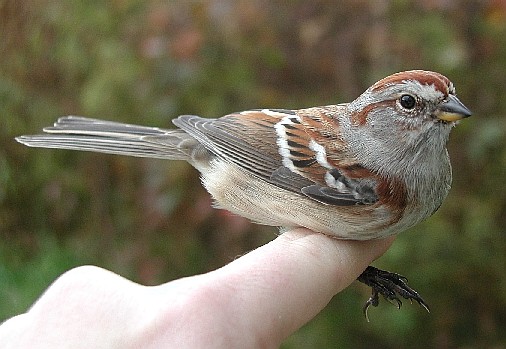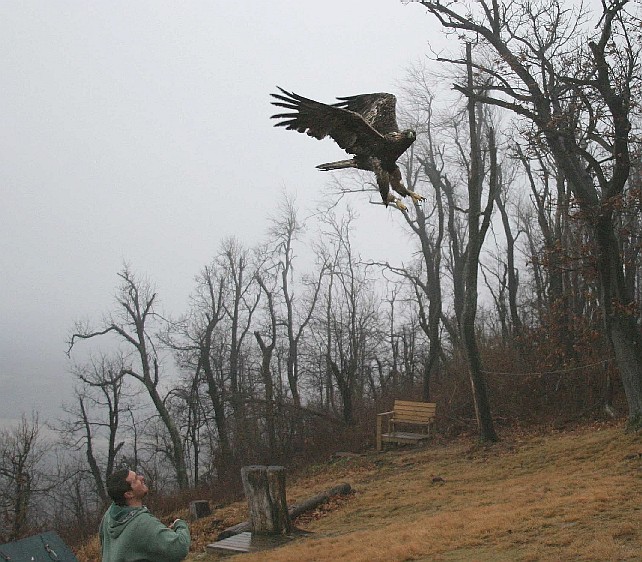Notes and Highlights for November 2006
The month of October was a hard act to follow, but November was one for the record books as well. It was a very productive month with a total of 1,506 birds banded; the second highest November total in the history of the program. Dark-eyed Junco topped the list this month with 444 banded, becoming the third highest November total for this species ever, following behind 571 banded in 1997 and 496 banded in 1992. This was also the highest November total for this species since 1997, when the 571 DEJU's mentioned above contributed to over a third of the month's 1,541 record total.
Coming in a distant second this month behind Dark-eyed Junco was American Goldfinch (248), followed by Golden-crowned Kinglet (189), White-throated Sparrow (164), and Ruby-crowned Kinglet (120).

Thankfully for the participants of this year's beginner bander development workshop, the dominant catch was juncos and not chickadees, as was the case last year. We appreciate everyone's participation in helping make it a successful, educational, and enjoyable week. In the photo below, from left to right and back to front is: Dean Thompson (PARC banding volunteer), Keith McKenrick and Bill Clark (workshop participants), Robert Mulvihill (PARC field ornithology projects coordinator), Robert Leberman (PARC senior bird bander emeritus), Emma Deleon (PARC seasonal banding assistant), Mary Alice Koeneke and Janet Creamer (workshop participants), Adrienne Leppold (PARC Bander-in-Charge), Felicity Newell (PARC seasonal banding assistant), "Puppy" Mulvihill, and Lauren Schneider (PARC Volunteer).
Thanks also to Mary Shidel, Trish Miller, Pam Ferkett (who took this photo), and Carol Leppold for additional help with banding this month.

There is not much difficulty in distinguishing between juvenile and adult Sharp-shinned and Cooper's Hawks, the two common accipiters banded at Powdermill. In both species, juveniles have vertical brown breast streaks that remain through their first winter until they undergo their second prebasic molt. This molt can begin as early as the onset of the breeding season but will often not complete until late summer. Adults, on the other hand, have wide horizontal rusty vermiculations on their breast.
Two Sharp-shinned Hawks caught on November 2nd, however, also provided a nice comparison of some easily overlooked, yet fundamental differences. The photo below shows the spread wings of both birds. HY birds can have a complete first prebasic molt but this does not usually commence until their first spring. So, in November, the HY bird (top) is still in juvenal plumage. Juvenal feathers, as seen below, are more brown and those on the upperparts usually have buffy edges. As is a general rule, juvenal feathers are also more loosely structured and just don't have the sheen and quality that adult feathers do (bottom).

While we've highlighted the change in eye color that takes place as hawks age on the website in the past, we couldn't resist one more comparison shot with an adult and HY bird in hand at the same time. We included the top photo from our archives of an after-third-year male to show the complete range of eye color development. The adult female in the middle is likely a TY bird, but some individuals (especially females) may never attain the very dark red eye color seen in the top photo. Based on the Sharp-shinned account in Palmer's Handbook of North American Birds, Vol. 4, birds with irises "deep orange" or various reds can definitely be assigned to Basic II and older. However, without any confirming retained juvenal feathers, defining the eye color as "deep orange" and not "light orange" would just be too subjective and potentially inaccurate. Thus, we aged her conservatively as an AHY bird (i.e., she could be anything from a precocious SY to an ATY). The bottom photo is, of course, from the HY bird.
Note also the differences between the male and females in the photos below. Again, the top bird was an ATY male and the other two were females. The cheeks of the females, the adult in particular, are much more widely streaked with rufous. In addition to a cleaner cheek, and also somewhat visible in these photos, is the more clean gray appearance of the head and back on the male.

That same day, we also caught our one and only Rusty Blackbird for the season, the HY male pictured below. As a result of meetings during the North American Ornithological Conference in Mexico this past October, we were invited to join the International Rusty Blackbird Technical Working Group (IRBTWG). Though one of the most dramatic of any North American bird, little is understood about the population decline in Rusty Blackbirds. Formed in 2005, and based out of the Migratory Bird Center at the Smithsonian National Zoological Park, the IRBTWG aims to develop a comprehensive, cross-seasonal research program to gain the information necessary for understanding the causes and significance of Rusty Blackbird declines. One of the short term goals is to establish connectivity between breeding and wintering ground populations through analysis of feather isotopes. Because more than 80% of the global population of Rusty Blackbirds depends on remote boreal forest during the breeding season, effectively studying these birds in many places on their breeding grounds is a significant challenge. For this reason, migration banding stations likely are integral for sampling large numbers of birds and collecting blood and feather samples for genetic and isotope analyses, contaminant studies, disease screening and, ultimately, effective population monitoring.
We have begun to collect additional morphometric measurements and feather samples from birds banded at Powdermill following established IRBTWG sampling protocols, but no real migration monitoring network for RUBLs presently exists. We are hoping to identify stations that are well-positioned for sampling large numbers of RUBLs during migration. If you are a bander, or know of an established banding station where large flocks of RUBL's (25 or more) are regularly observed during migration, please contact us at leppold@pabirdatlas.org. If you observe or catch smaller numbers of Rusty Blackbirds, the group can still use your help. To learn more about the status of this species, progress within the working group, and ways birders and banders can help, please visit - http://nationalzoo.si.edu/ConservationAndScience/MigratoryBirds/Research/Rusty_Blackbird/

This HY Ovenbird was certainly an unexpected catch on the late date of 7 November. We have just one other November banding record of this species in our database, also an HY banded on 23 November 1985.

While a report of a Rufous Hummingbird in late November is no longer unexpected in our region, we certainly didn't expect to discover one that was already banded!! Yes, the second RUHU we caught this year turned out to be our first foreign recovery!
This adult female captured on 22 November in McDonald, PA was originally banded in Diamondhead, MS on 25 January 2006 by Mark Myers. It showed up at Ray and Edyie Posel's house around 20 October and was the first record of this species for Washington County, Pennsylvania. It is also one of just a few recoveries of a western hummingbird species in the northeastern U.S. and the first foreign recovery of a Rufous Hummingbird in PA. Many thanks to Bob and Martha Sargent of the Hummer/Bird Study Group who first began efforts to band these "western" hummingbirds in the east, and for enlisting other banders, such as Mark and ourselves, to contribute to this now very widespread effort. N-71927 certainly added an important piece of information to our understanding of the migratory routes and timing for these eastern Selasphorus sp. While the exact breeding grounds for this individual is still unknown, our recovery strengthens speculation that birds caught in the Northeast are, in fact, stopover migrants on their way to the southeastern U.S. for the winter.

In the photo, Bob Mulvihill hands our special catch of the day to homeowners Edyie and Ray Posel for the release.
Thank you Ray and Edyie for your hospitality, your invitation for us to come and catch what turned out to be a very special bird, and, last but not least, for your enthusiasm.
The last observed date for N-71927 was at the neighbor's feeder on 19 December. It will certainly be interesting to see if she turns up at the same house in Mississippi later this winter.


Our first American Tree Sparrow was banded on 11 November and proved to be a very photogenic individual.

While we made efforts on a number of occasions to catch a Northern Saw-whet Owl this fall, we only ever caught one Eastern Screech Owl. This sleepy-looking fellow, a particularly brown individual, was the third and final owl banded in 2006.

We banded our second Wilson's Snipe for the season early this month and, we think, it was well posed for the upcoming Thanksgiving holiday.

Without a doubt, though, we had an even bigger and better Thanksgiving holiday treat...
After nearly a month's trapping effort, we were finally successful in catching our first Golden Eagle for the year. Yes, a Golden Eagle, and on Thanksgiving Day! In the photo below, Mike Lanzone, PARC Assistant Field Ornithology Projects Coordinator, and Trish Miller, PARC GIS Manager, hold the eagle for a spread wing back photo before it is released.

The story behind this capture began more than a year ago when Bob Mulvihill and Mike Lanzone approached Todd Katzner, Director of Conservation and Field Research at the National Aviary in Pittsburgh, about collaborating on a research project to study the migration patterns of Golden Eagles throughout the Appalachian Region of the eastern U.S. After a successful pilot study last fall, we acquired three satellite transmitters and spent the month of October building the blinds and bow traps necessary to catch these large, very smart, powerful birds.

In addition to covering the blinds at the trapping sites with live branches, trees and shrubs were painted on the outside of the blinds as camouflage.

The backdoor on the finished blinds

Trapping stations were then set up on three sites--two along the Allegheny Front and one on Bald Eagle Ridge. As mentioned above, it was nearly a month before the first eagle was caught on Thanksgiving Day. Just a few days later, a second eagle was caught and banded. Both have been fitted with solar-powered satellite transmitters that will take precise GPS fixes every hour during daylight hours. The photo below shows a close up of the transmitter with solar powered battery that is fitted onto the eagle using a backpack style harness.

The eastern population of Golden Eagles is distinct and of conservation concern because observations from principal hawk watch sites in PA suggest most of the eagles concentrate along a comparatively narrow swath of western and central ridges in the Allegheny mountains during migration. These same ridge tops are also under increasing pressure for development by the wind energy industry, creating the potential for conflict with migrating eagles and other birds. The satellite tracking devices used in this study will not only continually give us the locations of the birds, but also record information regarding the altitude and speed at which the birds are flying and how this varies with weather conditions. With this information, we hope to be able to make solid, science-based recommendations concerning wind energy development in the region that will greatly reduce the possibility that eagles and other migrant birds will collide with wind turbines. An additional conservation benefit of this project concerns the knowledge we are gaining every day about the wintering areas and movements of the telemetered eagles. Powdermill GIS Coordinator, Trish Miller, has created and regularly updates maps showing the locations and movements of the two eagles marked this fall. To read more about this project and view the maps, please visit the National Aviary website.
We owe HUGE thanks to Tom Dick, Marsha and Bruce Bonta, and the B. Dale Miller Family for allowing us to trap on their properties. Incidentally, both eagles were caught in the Miller fields just below the Allegheny Front Hawk Watch, and both were released from the overlook at the hawk watch. We also greatly appreciate the cooperation and support of the many hawk watchers at Allegheny Front.

Finally, we caught our 10,000th bird for the fall on 30 November, this HY female American Goldfinch. This is only the third fall season where we have ever caught over 10,000 birds. Our final fall 2006 season total was 10,022, the third highest in the history of the program. 10,655 in 2001 and 10,129 in 1982 still hold first and second place.
